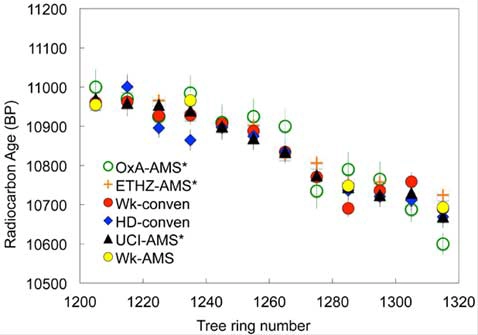The Waikato Radiocarbon Dating laboratory led an international 5-lab 14C inter-comparison, which represents a benchmark for determining accuracy and reproducibility. The 5 labs analysed 12 successive decadal kauri samples ~10,000 14C years in age with the high resolution sampling providing laboratory offset information previously unavailable in other inter-comparisons.
This type of quality assurance (QA) programme is a far more effective measure of 14C QA than any ISO quality accreditation. The Waikato Radiocarbon Dating laboratory results (both radiometric and AMS) were found to be highly consistent with the other labs. The radiocarbon community has since recognised the excellence of this research and some of the samples will be utilised in the next International Radiocarbon Inter-comparison exercise. The results are published in Radiocarbon with the paper free to download.
Inter-comparison results for 12 successive ~10ka kauri samples—final results

Inter-comparison results for 12 successive ~10ka kauri samples—final results. (OxA = University of Oxford; ETHZ = Laboratory of Ion Beam Physics; Wk = University of Waikato-conven; Waikato-AMS; HD = University of Heidelberg; UCI = University of California at Irvine).
To measure laboratory reproducibility and crosscheck our results, we are also involved in inter-calibration exercises with the radiocarbon community. We have participated in all of the Glasgow University programs (including the recent 6th international radiocarbon inter-comparison) and the earlier International Atomic Energy Agency (IAEA) inter-comparison exercise. Results of the 5th inter-comparison (VIRI) are given in the table below and show a high level of agreement between the Waikato Radiocarbon Dating lab determinations and VIRI consensus values.
Results of the Fifth International radiocarbon Inter-comparison (VIRI; 2007-2010) showing consensus values vs. University of Waikato results.
| University of Waikato ResultsVIRI Sample | |||
| VIRI Sample | - Standard Radiometric | - AMS | VIRI consensus values |
| Sample A (barley mash) | 109.2 ± 04 yr BP | 109.5 ± 0.53 yr BP | 109.1 ± 0.4 pMC |
| Sample B (seed charred) | 2855 ± 32 yr BP |
2802 ± 33 yr BP |
2820 ± 3.3 yr BP |
| Sample C (barley mash) |
111.0 ± 0.4 pMC |
111.02 ± 0.42 pMC |
110.7 ± 0.04 pMC |
| Sample D (seed charred) |
2842 ± 33 yr BP |
2804 ± 32 yr BP |
2836 ± 3.3 yr BP |
| Sample E (mammoth bone) |
38347 ± 511 yr BP |
40,809 ± 2239 yr BP |
39,305 ± 121 yr BP |
| Sample F (horse bone) |
2545 ± 30 yr BP |
2477 ± 37 yr BP |
2513 ± 5 yr BP |
| Sample G (human bone) | - |
1035 ± 32 yr BP |
969 ± 5 yr BP |
| Sample H (whale bone) |
9491 ± 45 yr BP |
9617 ± 49 yr BP |
9528 ± 7 yr BP |
| Sample I (whale bone) |
8360 ± 37 yr BP |
8318 ± 43 yr BP |
8331 ± 6 yr BP |
| Sample J (humic acid) | - |
41,795 ± 1860 |
43226 ± 140 yr BP |
| Sample K (wood) |
0.04 ± 0.04 pMC |
0.09 ± 0.1 pMC |
0.058 ± 0.06 pMC |
| Sample L (wood) |
2269 ± 26 yr BP |
2241 ± 30 yr BP |
2234 ± 5 yr BP |
| Sample M (wood) | - |
2442 ± 30 yr BP |
2430 ± 4 yr BP |
| Sample N (cellulose) | - |
2417 ± 36 yr BP |
2436 ± 5 yr BP |
| Sample O (cellulose) |
99 ± 25 yr BP |
75 ± 30 yr BP |
125 ± 5 yr BP |
| Sample P (charcoal) |
1751 ± 27 yr BP |
- |
1747 ± 9 yr BP |
| Sample Q (charcoal) | - |
600 ± 30 yr BP |
636 ± 5 yr BP |
| Sample R (shell) |
2469 ± 26 yr BP |
2419 ± 30 yr BP |
2491 ± 4 yr BP |
| Sample S (barley mash) |
110.46 ± 0.36 pMC |
110.2 ± 0.4 pMC |
109.96 ± 0.04 pMC |
| Sample T (humic acid) | - |
3335 ± 30 yr BP |
3360 ± 4 yr BP |
| Sample U (humic acid) | 11829 ± 41 yr BP | 11746 ± 87 yr BP | 11778 ± 6 yr BP |
* pMC = Percent Modern Carbon.